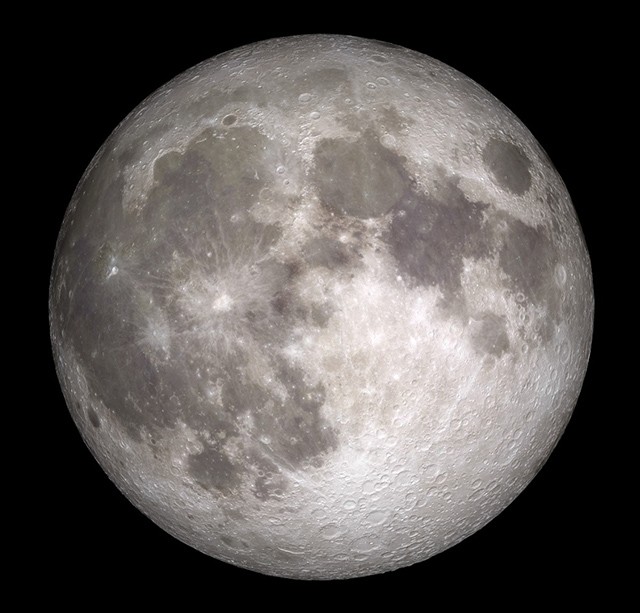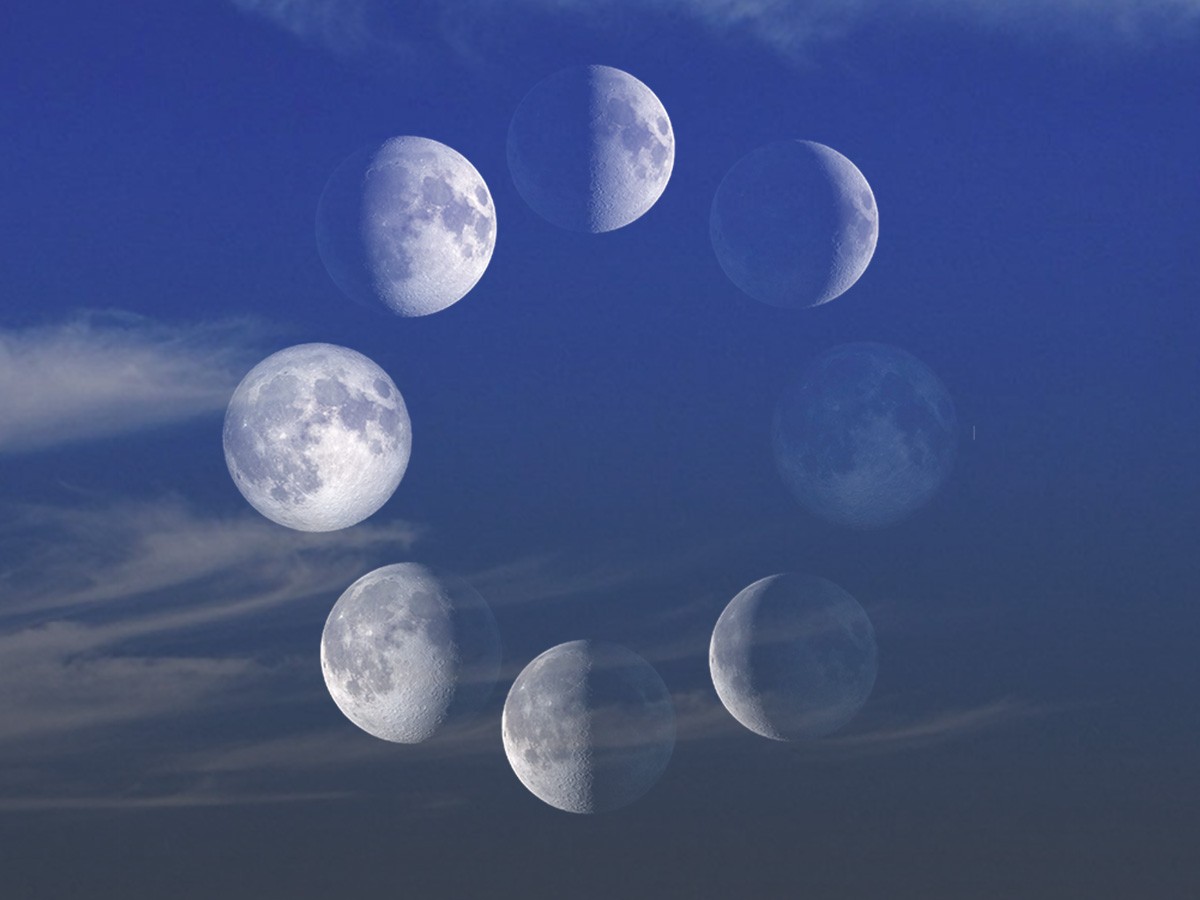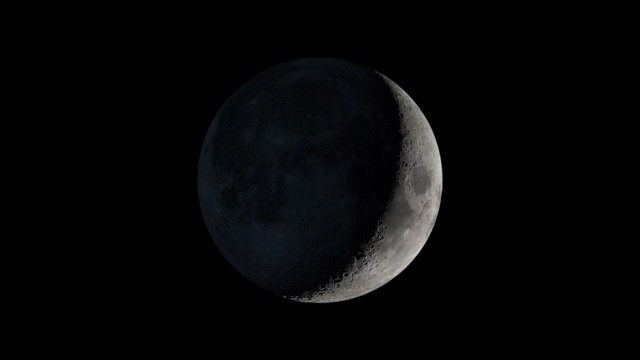What Is The Lunar Cycle? Exploring the lunar cycle unveils the fascinating dance between the Earth, the Moon, and the Sun, revealing the captivating phases of the Moon that have intrigued humanity for centuries. At WHAT.EDU.VN, we aim to illuminate this celestial phenomenon, offering clear explanations and answering all your questions about lunar phases. Let’s discover the lunar month, synodic month and the monthly cycle together.
1. Decoding the Lunar Cycle: An Overview
The lunar cycle, also referred to as the moon cycle or phases of the moon, describes the changing appearance of the Moon as it orbits the Earth. This cycle, lasting approximately 29.5 days, is dictated by the Moon’s position relative to the Sun and Earth. As the Moon orbits, different amounts of its sunlit surface become visible to us, creating the different phases we observe.
- Synodic Period: The period it takes for the Moon to go through all its phases (approximately 29.5 days).
- Tidal Effects: The lunar cycle significantly influences Earth’s tides.
- Cultural Significance: Many cultures worldwide have traditions and festivals linked to specific lunar phases.
2. The Eight Primary Lunar Phases Explained
The lunar cycle is traditionally divided into eight distinct phases, each with its unique appearance and characteristics. Here’s a breakdown of each phase:
2.1. New Moon: The Invisible Start
The New Moon phase marks the beginning of the lunar cycle. During this phase, the Moon is positioned between the Earth and the Sun. Its illuminated side faces away from Earth, rendering it invisible to the naked eye. This phase is often associated with new beginnings and introspection. The moon isn’t usually directly between the Earth and the Sun, it only passes near the Sun from our perspective on Earth.
2.2. Waxing Crescent: A Sliver of Light
Following the New Moon, a sliver of light begins to appear on the right side of the Moon. This is the Waxing Crescent phase. “Waxing” means growing or increasing in illumination. The crescent gradually becomes larger each night as the Moon continues its orbit. Every day, the Moon rises a little bit later.
2.3. First Quarter: Halfway to Full
When half of the Moon’s face is illuminated, we reach the First Quarter phase. It is called “quarter” not because we see a quarter of the Moon, but because the Moon has traveled a quarter of the way through its orbit. A first quarter moon rises around noon and sets around midnight. It’s high in the sky in the evening and makes for excellent viewing.
2.4. Waxing Gibbous: Approaching Fullness
After the First Quarter, more than half of the Moon is illuminated, entering the Waxing Gibbous phase. “Gibbous” means bulging or rounded. The illuminated portion continues to grow each night, leading up to the Full Moon. Now most of the Moon’s dayside has come into view, and the Moon appears brighter in the sky.
2.5. Full Moon: A Circle of Light
The Full Moon is perhaps the most recognizable and celebrated lunar phase. During this phase, the Earth is positioned between the Sun and the Moon, fully illuminating the Moon’s surface. A full moon rises around sunset and sets around sunrise. The Moon will appear full for a couple of days before it moves into the next phase.
2.6. Waning Gibbous: Light Begins to Fade
Following the Full Moon, the illuminated portion begins to decrease, entering the Waning Gibbous phase. “Waning” means shrinking or decreasing in illumination. The lighted side appears to shrink, but the Moon’s orbit is simply carrying it out of view from our perspective. The Moon rises later and later each night.
2.7. Third Quarter: The Other Half
Similar to the First Quarter, the Third Quarter phase (also known as Last Quarter) occurs when half of the Moon is illuminated. However, this time, the opposite half is lit compared to the First Quarter. The Moon looks like it’s half illuminated from the perspective of Earth, but really you’re seeing half of the half of the Moon that’s illuminated by the Sun ― or a quarter. A last quarter moon, also known as a third quarter moon, rises around midnight and sets around noon.
2.8. Waning Crescent: A Fading Glow
The final phase of the lunar cycle is the Waning Crescent. The Moon is nearly back to the point in its orbit where its dayside directly faces the Sun, and all that we see from our perspective is a thin curve. Only a small sliver of light remains, gradually shrinking until the Moon disappears into the New Moon phase, beginning the cycle anew.
3. Lunar Libration: The Moon’s Subtle Dance
Beyond the familiar phases, the Moon exhibits a subtle “wobble” known as libration. This phenomenon allows us to see slightly more than 50% of the Moon’s surface over time. This visualization of the Moon’s phases throughout the year also shows lunar libration, the apparent rolling motion that changes our view of the Moon slightly over time. NASA’s Science Visualization Studio.
3.1. Libration in Longitude
This occurs because the Moon’s orbit is not perfectly circular. When the Moon is at its closest to Earth and moving most quickly along its orbital path, the Moon itself doesn’t rotate quite fast enough to keep entirely the same side facing us, and we get to see a little more of the eastern side of the Moon. When the Moon is farthest from Earth and orbiting at its slowest, its rotation gets a little ahead, and we see a bit more of its western side. We call this motion “libration in longitude.”
3.2. Libration in Latitude
The 5 degree tilt of the Moon’s orbit also causes it to appear to nod, as though it were saying “yes.” The tilt sometimes brings the Moon above Earth’s northern hemisphere, and sometimes below Earth’s southern hemisphere, allowing us to see slightly more of the northern or southern hemispheres of the Moon. We call this motion “libration in latitude.”
3.3. The Tilted Ramp
Finally, the Moon appears to tilt back and forth like a metronome. The tilt of the Moon’s orbit contributes to this, but it’s mostly due to the tilt of our Earth. Earth has a tilt of 23.5 degrees on its axis, which means that when we observe the Moon from Earth, it’s a little like we’re standing sideways on a ramp. If you look left, the ramp slopes up. If you look right, the ramp slopes down. In front of you, the horizon looks higher on the right and lower on the left. If you turn around, the horizon appears to tilt the opposite way.
The tilted ramp works the same as the tilted “platform” of the Earth beneath our feet. Every two weeks, we have to look in the opposite direction to see the Moon, and the ground beneath our feet is then tilted the opposite way as well.
4. Earthshine: A Ghostly Glow
During the crescent phases, you might notice a faint glow illuminating the dark portion of the Moon. This phenomenon, known as earthshine, is caused by sunlight reflecting off the Earth and onto the Moon. Though the Moon is in a crescent phase in this photograph, most of the darkened, Earth-facing side of the Moon is still dimly visible, illuminated by sunlight reflecting off our planet. This reflected light is called earthshine.
5. Daytime Moons: A Pale Presence
While the Moon is most often associated with the night sky, it can also be visible during the day. The best times to see a daytime Moon are perhaps during the first and last quarter phases, when the Moon is high enough above the horizon and at about 90 degrees from the Sun in the sky. This helps make the Sun’s reflected light bright enough to see as it reflects off of the Moon. The Moon can be seen in the daylit sky at any phase except for the new moon, when it’s invisible to us, and full moon, when it’s below the horizon during the day. The crescent through quarter phases are high in the sky during the day, but the daytime gibbous phases can be glimpsed only just before the Sun sets.
6. The Moon’s Orbit and Synchronous Rotation
The Moon orbits Earth from a viewpoint above the North Pole in this animation. The blue gridlines show how the same side of the Moon always faces Earth. The size of the Earth and Moon are enlarged 20 times. Credit: NASA’s Scientific Visualization Studio
6.1. Orbital Distance and Period
From your astronaut’s viewpoint, you can see that the Moon is an average of 238,855 miles (384,399 km) from Earth, or about the space that could be occupied by 30 Earths. It travels around our planet once every 27.322 days in an elliptical orbit, an elongated circle. (It takes about 27.3 days to complete a revolution, but 29.5 days to change from new moon to new moon.)
6.2. Tidal Locking
The Moon is tidally locked with Earth, which means that it spins on its axis exactly once each time it orbits our planet. Because of this, people on Earth only ever see one side of the Moon. We call this motion synchronous rotation.
7. Cultural Significance of the Lunar Cycle
Across cultures, the lunar cycle holds immense significance, influencing calendars, agriculture, and spiritual beliefs. The phases of the Moon have been used to track time, predict tides, and guide planting and harvesting seasons. Many religions and spiritual practices also incorporate lunar cycles into their rituals and celebrations.
8. Frequently Asked Questions About the Lunar Cycle
To further enhance your understanding of the lunar cycle, here are some frequently asked questions:
| Question | Answer |
|---|---|
| How long does a lunar cycle last? | Approximately 29.5 days. |
| What causes the phases of the Moon? | The changing angles at which we see the Moon’s illuminated surface as it orbits Earth. |
| What is a blue moon? | A blue moon is either the third full moon in a season with four full moons or the second full moon in a calendar month. |
| Does the lunar cycle affect human behavior? | While there is no conclusive scientific evidence to support a direct link, some people believe the lunar cycle influences mood and behavior. |
| How does the lunar cycle affect tides? | The Moon’s gravitational pull is the primary cause of Earth’s tides. Full and new moons result in higher tides (spring tides). |
| Can I see the Moon during the day? | Yes, the Moon can often be seen during the day, especially during the crescent and quarter phases. |
| What is the dark side of the Moon? | There is no “dark side.” All parts of the Moon receive sunlight at some point during its orbit. The “far side” is simply the side we cannot see from Earth due to tidal locking. |
| What are the best resources for tracking the lunar cycle? | NASA provides excellent resources, including a daily moon guide and visualizations of moon phases. Websites and apps dedicated to astronomy can also provide accurate lunar phase information. |
| How does the lunar cycle affect agriculture? | Some farmers follow lunar cycles for planting and harvesting, believing that certain phases are more conducive to plant growth. This practice is rooted in traditional knowledge and anecdotal evidence. |
| Are there any upcoming lunar events I should watch out for? | Keep an eye out for lunar eclipses, supermoons, and other celestial events that enhance the beauty and wonder of the lunar cycle. |






9. Exploring the Moon Further
9.1. NASA Resources
Check out NASA’s interactive map for observing the Moon each day of the year.
Go to the guide about Daily Moon Guide
9.2. Moon Observation Journal
Spend the next month getting to know the Moon.
Moon Observation Journal
9.3. Moon Phases, 2025
This visualization shows the Moon’s phase at hourly intervals throughout 2025.
Moon Phase and Libration 2025
9.4. Moon Phases, 2024
This visualization shows the Moon’s phase at hourly intervals throughout 2024.
Moon Phase and Libration 2024
10. Dive Deeper: Advanced Lunar Concepts
For those seeking a more in-depth understanding, let’s explore some advanced concepts related to the lunar cycle:
10.1. Sidereal vs. Synodic Month
- Sidereal Month: The time it takes the Moon to complete one orbit around Earth with respect to the fixed stars (approximately 27.3 days).
- Synodic Month: The time it takes the Moon to go through all its phases (approximately 29.5 days). The synodic month is longer than the sidereal month because Earth is also moving around the Sun.
10.2. Lunar Eclipses
A lunar eclipse occurs when the Earth passes between the Sun and Moon, casting a shadow on the Moon. Lunar eclipses can be total, partial, or penumbral, depending on how much of the Moon is covered by Earth’s shadow.
10.3. Supermoons and Micromoons
- Supermoon: A full moon that occurs when the Moon is at its closest point to Earth in its orbit, making it appear slightly larger and brighter than usual.
- Micromoon: A full moon that occurs when the Moon is at its farthest point from Earth, making it appear smaller than usual.
10.4. The Saros Cycle
The Saros cycle is a period of approximately 18 years, 11 days, and 8 hours after which eclipses of the Sun and Moon recur in a nearly identical pattern. This cycle has been known since ancient times and is used to predict future eclipses.
11. The Lunar Cycle and You
11.1. Observing the Moon
One of the best ways to appreciate the lunar cycle is to observe the Moon yourself. With just your eyes, you can track the changing phases and notice subtle details like earthshine. For a closer look, use binoculars or a telescope.
11.2. Photography
The Moon is a popular subject for photographers. Experiment with different lenses and settings to capture the beauty of the lunar phases.
11.3. Moon Gazing Apps
There are many apps available that can help you track the lunar cycle, identify moon phases, and even locate the Moon in the sky.
12. Let WHAT.EDU.VN Answer Your Questions About Space
Understanding the lunar cycle opens a window into the fascinating world of astronomy and our place in the universe. The lunar cycle is not only a beautiful celestial display but also a fundamental influence on Earth’s environment and culture.
Still have questions about the lunar cycle? Or perhaps you’re curious about other astronomical phenomena? Don’t hesitate to ask your questions on WHAT.EDU.VN. We provide a platform for curious minds of all ages to explore the wonders of the cosmos and beyond. Our team of experts and community members are ready to provide clear, accurate, and engaging answers to your questions.
At WHAT.EDU.VN, we understand that finding reliable answers to your questions can be challenging. That’s why we’ve created a platform where you can ask anything and receive answers quickly and for free. Whether you’re a student, a professional, or simply someone with a thirst for knowledge, we’re here to help.
Do you find it difficult to get answers to your questions?
Are you looking for a reliable source of information?
Do you want to connect with a community of knowledgeable individuals?
WHAT.EDU.VN is here to help. We offer a free platform where you can ask any question and receive answers from experts and community members. Our goal is to make learning accessible and enjoyable for everyone.
Ready to get your questions answered?
Visit WHAT.EDU.VN today and start exploring the world of knowledge. It’s easy, it’s free, and it’s waiting for you.
Contact Us:
- Address: 888 Question City Plaza, Seattle, WA 98101, United States
- WhatsApp: +1 (206) 555-7890
- Website: what.edu.vn
We look forward to helping you on your journey of discovery.
